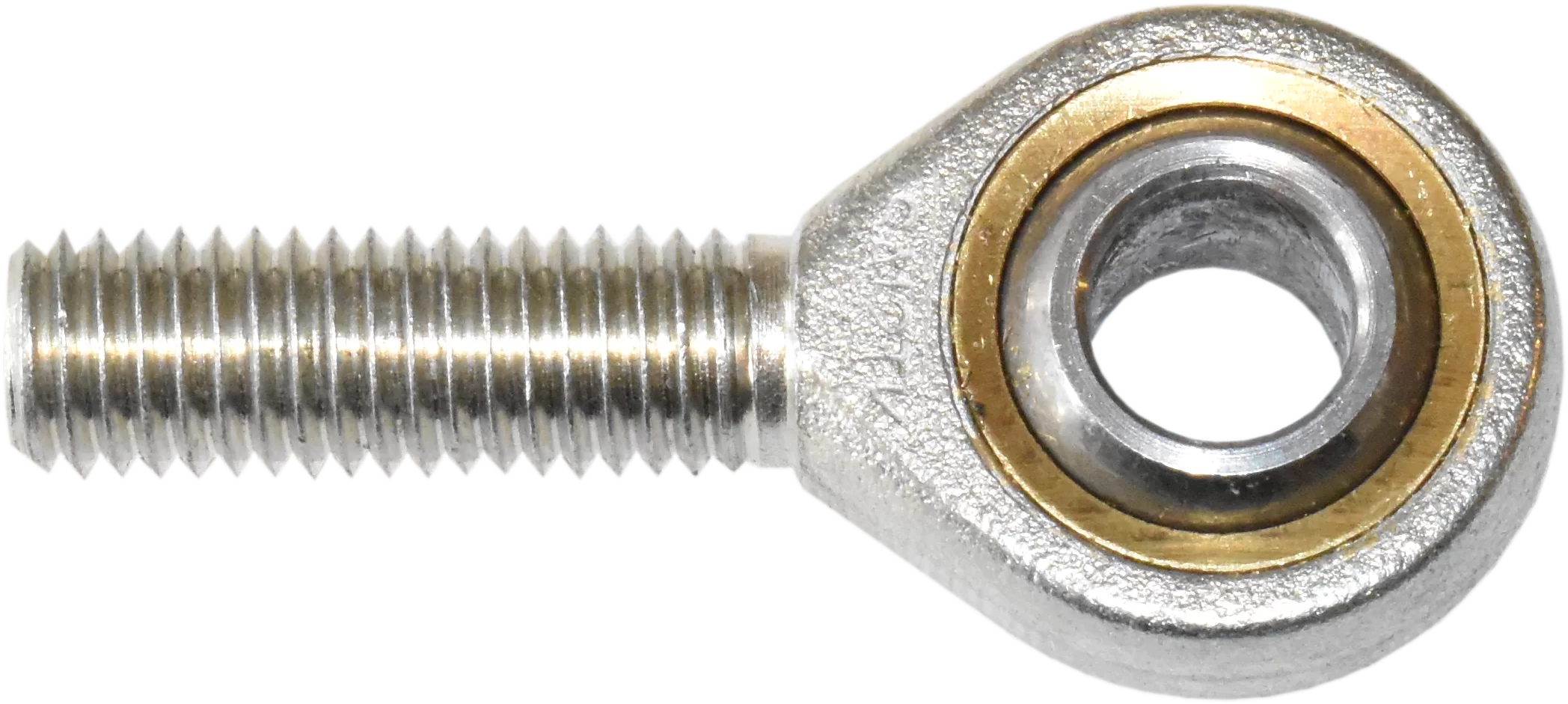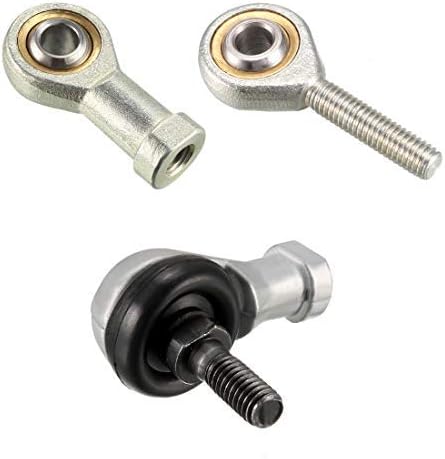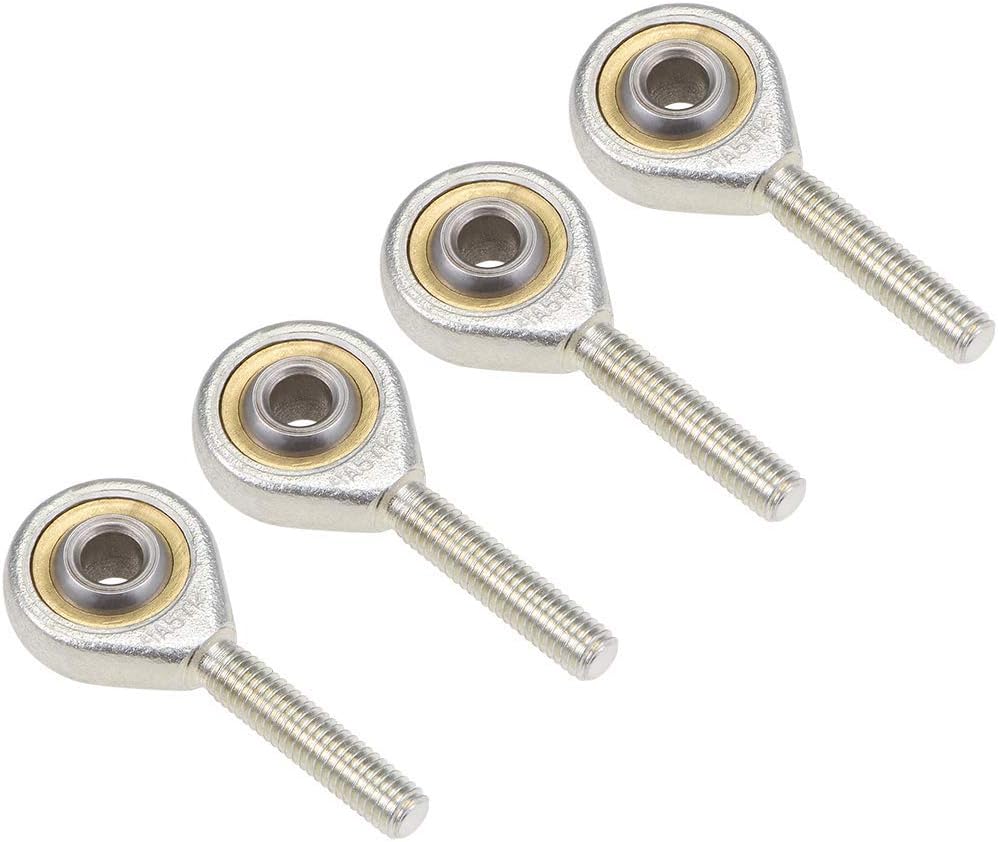Product Description
GEG230XS-2RS Ball Joint Bearing Radial Spherical Plain Bearing GEG 230 XS-2RS-L571
|
Part Number |
GEZ 500 ES-2RS |
|
Bearing Type |
Spherical Plain Bearings |
|
Stock Status |
Rich stock, guarantee quick delivery |
|
Special Customization |
Acceptable |
|
Packaging |
Industrial packing; |
Product Description
| Bearing No. | Dimensions(mm) | Load ratings KN |
a° ≈ |
weight ≈ kg |
|||||||
| d | D | B | c | dk | rs | r1s | Dynamic | Static | |||
| GE15ES-2RS | 15 | 26 | 12 | 9 | 22 | 0.3 | 0.3 | 16 | 84 | 8 | 0.571 |
| GE17ES-2RS | 17 | 30 | 14 | 10 | 25 | 0.3 | 0.3 | 21 | 106 | 10 | 0.041 |
| GE20ES-2RS | 20 | 35 | 16 | 12 | 29 | 0.3 | 0.3 | 30 | 146 | 9 | 0.066 |
| GE25ES-2RS | 25 | 42 | 20 | 16 | 35.5 | 0.6 | 0.6 | 48 | 240 | 7 | 0.119 |
| GE30ES-2RS | 30 | 47 | 22 | 18 | 40.7 | 0.6 | 0.6 | 62 | 310 | 6 | 0.153 |
| GE35ES-2RS | 35 | 55 | 25 | 20 | 47 | 0.6 | 1 | 79 | 399 | 6 | 0.233 |
| GE40ES-2RS | 40 | 62 | 28 | 22 | 53 | 0.6 | 1 | 99 | 495 | 7 | 0.306 |
| GE45ES-2RS | 45 | 68 | 32 | 25 | 60 | 0.6 | 1 | 127 | 637 | 7 | 0.427 |
| GE50ES-2RS | 50 | 75 | 35 | 28 | 66 | 0.6 | 1 | 156 | 780 | 6 | 0.546 |
| GE55ES-2RS | 55 | 85 | 40 | 32 | 74 | 0.6 | 1 | 200 | 1000 | 7 | 0.939 |
| GE60ES-2RS | 60 | 90 | 44 | 36 | 80 | 1 | 1 | 245 | 1220 | 6 | 1.04 |
| GE70ES-2RS | 70 | 105 | 49 | 40 | 92 | 1 | 1 | 313 | 1560 | 6 | 1.55 |
| GE80ES-2RS | 80 | 120 | 55 | 45 | 105 | 1 | 1 | 400 | 2000 | 6 | 2.31 |
| GE90ES-2RS | 90 | 130 | 60 | 50 | 115 | 1 | 1 | 488 | 2440 | 5 | 2.75 |
| GE100ES-2RS | 100 | 150 | 70 | 55 | 130 | 1 | 1 | 607 | 3030 | 7 | 4.45 |
| GE110ES-2RS | 110 | 160 | 70 | 55 | 140 | 1 | 1 | 654 | 3270 | 6 | 4.82 |
| GE120ES-2RS | 120 | 180 | 85 | 70 | 160 | 1 | 1 | 950 | 4750 | 6 | 8.05 |
| GE140ES-2RS | 140 | 210 | 90 | 70 | 180 | 1 | 1 | 1070 | 5350 | 7 | 11.02 |
| GE160ES-2RS | 160 | 230 | 105 | 80 | 200 | 1 | 1 | 1360 | 6800 | 8 | 14.01 |
| GE180ES-2RS | 180 | 260 | 105 | 80 | 225 | 1.1 | 1.1 | 1530 | 7650 | 6 | 18.65 |
| GE200ES-2RS | 200 | 290 | 130 | 100 | 250 | 1.1 | 1.1 | 2120 | 10600 | 7 | 28.03 |
| GE220ES-2RS | 220 | 320 | 135 | 100 | 275 | 1.1 | 1.1 | 2320 | 11600 | 8 | 35.51 |
| GE240ES-2RS | 240 | 340 | 140 | 100 | 300 | 1.1 | 1.1 | 2550 | 12700 | 8 | 39.91 |
| GE260ES-2RS | 260 | 370 | 150 | 110 | 325 | 1.1 | 1.1 | 3030 | 15190 | 7 | 51.54 |
| GE280ES-2RS | 280 | 400 | 155 | 120 | 350 | 1.1 | 1.1 | 3570 | 17850 | 6 | 65.06 |
| GE300ES-2RS | 300 | 430 | 165 | 120 | 375 | 1.1 | 1.1 | 3800 | 19100 | 7 | 78.07 |
Detailed Photos
Pictures of Related Products
Strict Testing Produre
Company Profile
Application of Bearing
Packaging & Shipping
FAQ
Q: Are you trading company or manufacturer ?
A: We are factory.We have our own brand:HQA,If you interested in our product,I can take you to visit our factory.
Q: How long is your delivery time?
A: Generally it is 5-10 days if the goods are in stock. or it is 15-20 days if the goods are not in stock, it is according to quantity.
Q: Where is your factory located? How can I visit there?
A: Our factory is located in ZheJiang Province,You can take the high-speed rail or plane to visit.
Q: Do you provide samples ? it is free charge?
A: Yes, we could offer the sample for free charge but do not pay the cost of freight.
Q:The MOQ is how much?
A: About ordinary standard type of bearing ,We have rich inventory,not have MOQ,if your need a
product is Non-standard size,need customize,we will according the product size to determine the MOQ.
/* January 22, 2571 19:08:37 */!function(){function s(e,r){var a,o={};try{e&&e.split(“,”).forEach(function(e,t){e&&(a=e.match(/(.*?):(.*)$/))&&1
| Contact Angle: | 0 |
|---|---|
| Aligning: | Non-Aligning Bearing |
| Separated: | Separated |
| Samples: |
US$ 0.01/Set
1 Set(Min.Order) | Order Sample |
|---|
.shipping-cost-tm .tm-status-off{background: none;padding:0;color: #1470cc}
| Shipping Cost:
Estimated freight per unit. |
about shipping cost and estimated delivery time. |
|---|
| Payment Method: |
|
|---|---|
|
Initial Payment Full Payment |
| Currency: | US$ |
|---|
| Return&refunds: | You can apply for a refund up to 30 days after receipt of the products. |
|---|

Improving Aircraft Functionality with Rod End Bearings
Rod end bearings play a critical role in enhancing the functionality and safety of various aircraft components, including control surfaces and landing gear. Here’s how:
Aircraft Control Surfaces:
Rod end bearings are commonly used in aircraft control systems to connect control surfaces, such as ailerons, elevators, and rudders, to control cables or rods. These bearings provide several key benefits:
- Articulation: Rod end bearings offer articulation capabilities, allowing control surfaces to move smoothly and precisely. This flexibility is essential for pilots to control the aircraft’s attitude, roll, pitch, and yaw.
- Misalignment Compensation: Aircraft structures experience various forces and vibrations during flight. Rod end bearings accommodate misalignment, ensuring that control systems remain effective even under dynamic conditions.
- Durability: Aircraft operate in challenging environments, and rod end bearings are designed to withstand extreme temperatures, vibrations, and mechanical stress. Their robust construction contributes to the longevity and reliability of control systems.
- Weight Savings: Aircraft design prioritizes weight reduction. Rod end bearings, typically made from lightweight materials like high-strength alloys or composites, help minimize the overall weight of the aircraft.
Landing Gear:
Rod end bearings are also utilized in landing gear systems, which are critical for safe takeoffs, landings, and ground operations. Their contributions include:
- Shock Absorption: Landing gear components, including rod end bearings, play a role in shock absorption during landing, reducing the impact forces transmitted to the aircraft’s structure and passengers.
- Articulation for Retraction and Extension: Rod end bearings enable the controlled movement of landing gear components, allowing for smooth retraction and extension. This is crucial for aerodynamic efficiency and safety.
- Structural Integrity: Rod end bearings help maintain the structural integrity of the landing gear assembly, ensuring that it can support the aircraft’s weight during ground operations.
Overall, rod end bearings in aircraft applications contribute to the precise control, safety, and structural reliability necessary for aviation. Their ability to handle articulation, misalignment, and challenging operating conditions makes them indispensable components in the aerospace industry.

Signs of Wear or Damage in Rod End Bearings and Replacement Guidelines
Rod end bearings are critical components in various mechanical systems, and it’s essential to monitor them for signs of wear or damage. Here are common indicators and guidelines for replacement:
1. Excessive Play or Looseness: If you notice excessive play or looseness in the rod end bearing, it’s a clear sign of wear. This can result in imprecise control and reduced system performance, so replacement is recommended.
2. Unusual Noises: Unusual noises such as knocking, clicking, or squeaking during movement are often indicative of rod end bearing issues. These noises can be a result of worn bearing surfaces or damaged components. Address the problem promptly to prevent further damage.
3. Corrosion or Rust: Exposure to moisture or harsh environmental conditions can lead to corrosion and rust on rod end bearings. Corroded bearings may not move smoothly, impacting system operation. If you observe significant corrosion, consider replacement.
4. Visible Damage: Any visible damage, such as cracks, dents, or deformation of the bearing’s body or components, should be taken seriously. Damaged rod end bearings can fail unexpectedly, leading to safety risks and system malfunctions. Replace them if damage is detected.
5. Reduced Range of Motion: If the rod end bearing restricts the range of motion or does not articulate smoothly, it may be worn or damaged. This can affect the performance of the associated system. Replacement is advisable to restore proper functionality.
6. Increased Friction: A sudden increase in friction during movement can indicate a lack of lubrication, contamination, or damage to the bearing surfaces. Re-greasing and cleaning may help, but if the issue persists, consider replacing the bearing.
7. Maintenance Intervals: Depending on the application, rod end bearings may have recommended maintenance intervals. Follow these guidelines and inspect the bearings during routine maintenance. If wear or damage is detected, replace them as necessary.
8. Safety Concerns: In safety-critical applications, it’s vital to prioritize bearing replacement at the first sign of wear or damage. Failure to do so can result in accidents or system failures with serious consequences.
Regular inspection and maintenance of rod end bearings are essential to ensure the continued reliability and performance of mechanical systems. When any of the above signs are observed, it’s advisable to replace the bearings promptly to prevent further issues and potential safety risks.

Design Principles and Functions of Rod End Bearings
Rod end bearings, also known as heim joints or rose joints, are essential components in various mechanical applications, where articulation and precise control of movement are required. These bearings are designed with specific principles and functions in mind:
Design Principles:
Rod end bearings consist of a spherical plain bearing, also known as a spherical plain bushing, within a housing. The design principles are as follows:
- Spherical Plain Bearing: The heart of a rod end bearing is a spherical plain bearing. This bearing allows the inner ring to tilt and rotate in multiple directions. It consists of an inner and outer ring with a sliding layer of material in between, often made from self-lubricating materials.
- Housing: The spherical plain bearing is housed within a protective casing, typically made of metal or other durable materials. The housing provides structural support and retains the bearing components.
- Threaded Shank: The outer part of the housing is often shaped as a threaded shank, allowing for easy attachment to various mechanical components, such as linkages or control arms.
- Lubrication Fittings: Many rod end bearings have provisions for lubrication fittings to ensure smooth articulation and reduce friction.
Functions:
Rod end bearings serve several crucial functions in mechanical systems:
- Articulation: Rod end bearings provide articulation, enabling components to pivot, swivel, and move in multiple directions. This function is vital in applications requiring flexibility and control over movement.
- Angular Misalignment Compensation: They can compensate for both static and dynamic angular misalignment. This is particularly useful in situations where components may not align perfectly due to varying factors like vibration or assembly tolerances.
- Load Transmission: Rod end bearings can transmit static and dynamic loads, making them suitable for applications involving force or load transfer. They are used in machinery and equipment where precise control of loads is essential.
- Precision Movement: These bearings provide precise control and movement, making them suitable for applications where accurate positioning of mechanical components is critical. This includes industries like aerospace and robotics.
- Corrosion Resistance: Many rod end bearings are designed with corrosion-resistant materials or coatings, making them suitable for use in harsh environments, such as marine and industrial settings.
- Durability: Rod end bearings are engineered for durability, allowing them to withstand challenging conditions and heavy-duty use. This ensures their reliability and longevity in demanding applications.
- Versatility: Rod end bearings are versatile components used across various industries, including automotive, aerospace, industrial machinery, and marine applications. Their adaptability and reliability make them valuable to engineers and designers.
These design principles and functions of rod end bearings make them indispensable in a wide range of mechanical systems where articulation, load-bearing capacity, and precise control are required.


editor by CX 2024-04-26